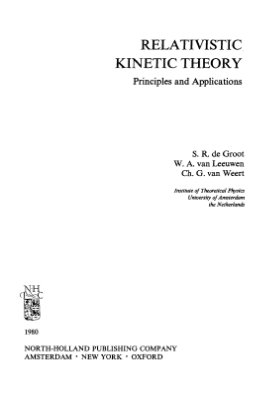North-Holland Publishing Company, 1980. 418 p. ISBN:0444854533
The basic aim of this book is to give a unified treatment of relativistic many-particle systems which are dilute in the sense that two-particle collisions constitute the predominant dynamical mechanism. The discussion relies principally on the relativistic version of Boltzmann's transport equation and the methods of solution of Chapman-Enskog and Maxwell-Grad. These techniques permit a complete discussion of the thermodynamic properties of dilute systems in and near equilibrium.
Shock waves and free flow situation, requiring a different approach, are not treated. We trust, however, that the material presented will make the original research on these subjects directly accessible to the reader. For the same reasons we have refrained from including a discussion of degenerate systems.
The structure of this monograph is based on a few guiding ideas. One is that relativistic kinetic theory is part of the larger body of statistical mechanics. We also wish to stress that the established principles of statistical mechanics are flexible enough for special relativity to be incorporated without major modifications. Indeed, it is the function of statistical mechanics to link the microscopic and macroscopic levels, and as such it ought to be applicable independently of the underlying dynamical description.
The basic aim of this book is to give a unified treatment of relativistic many-particle systems which are dilute in the sense that two-particle collisions constitute the predominant dynamical mechanism. The discussion relies principally on the relativistic version of Boltzmann's transport equation and the methods of solution of Chapman-Enskog and Maxwell-Grad. These techniques permit a complete discussion of the thermodynamic properties of dilute systems in and near equilibrium.
Shock waves and free flow situation, requiring a different approach, are not treated. We trust, however, that the material presented will make the original research on these subjects directly accessible to the reader. For the same reasons we have refrained from including a discussion of degenerate systems.
The structure of this monograph is based on a few guiding ideas. One is that relativistic kinetic theory is part of the larger body of statistical mechanics. We also wish to stress that the established principles of statistical mechanics are flexible enough for special relativity to be incorporated without major modifications. Indeed, it is the function of statistical mechanics to link the microscopic and macroscopic levels, and as such it ought to be applicable independently of the underlying dynamical description.

